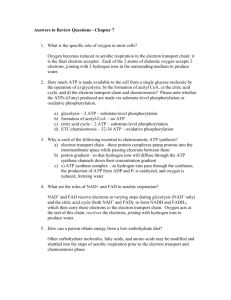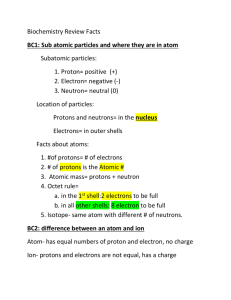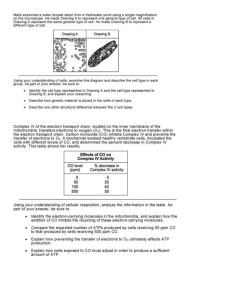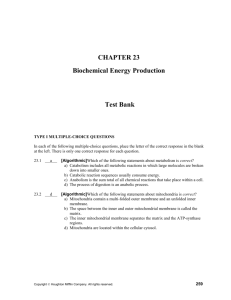1 - Ltcconline.net
advertisement
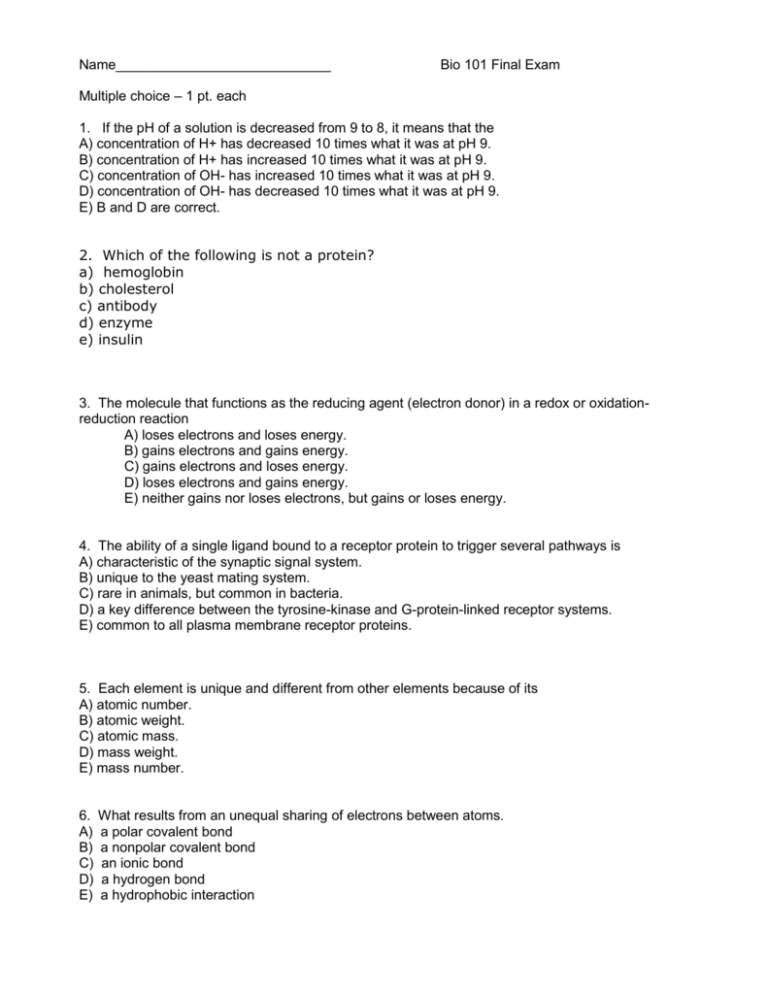
Name____________________________ Bio 101 Final Exam Multiple choice – 1 pt. each 1. If the pH of a solution is decreased from 9 to 8, it means that the A) concentration of H+ has decreased 10 times what it was at pH 9. B) concentration of H+ has increased 10 times what it was at pH 9. C) concentration of OH- has increased 10 times what it was at pH 9. D) concentration of OH- has decreased 10 times what it was at pH 9. E) B and D are correct. 2. Which of the following is not a protein? a) hemoglobin b) cholesterol c) antibody d) enzyme e) insulin 3. The molecule that functions as the reducing agent (electron donor) in a redox or oxidationreduction reaction A) loses electrons and loses energy. B) gains electrons and gains energy. C) gains electrons and loses energy. D) loses electrons and gains energy. E) neither gains nor loses electrons, but gains or loses energy. 4. The ability of a single ligand bound to a receptor protein to trigger several pathways is A) characteristic of the synaptic signal system. B) unique to the yeast mating system. C) rare in animals, but common in bacteria. D) a key difference between the tyrosine-kinase and G-protein-linked receptor systems. E) common to all plasma membrane receptor proteins. 5. Each element is unique and different from other elements because of its A) atomic number. B) atomic weight. C) atomic mass. D) mass weight. E) mass number. 6. A) B) C) D) E) What results from an unequal sharing of electrons between atoms. a polar covalent bond a nonpolar covalent bond an ionic bond a hydrogen bond a hydrophobic interaction 7. One liter of a solution of pH 2 has how many more hydrogen ions (H+) than 1 L of a solution of pH 7? A) 4 times more B) 400 times more C) 4,000 times more D) 10,000 times more E) 100,000 times more 8. Inside an active mitochondrion, most electrons follow which pathway? A) glycolysis → NADH → oxidative phosphorylation → ATP → oxygen B) citric acid cycle → FADH2 → electron transport chain → ATP C) electron transport chain → citric acid cycle → ATP → oxygen D) pyruvate → citric acid cycle → ATP → NADH → oxygen E) citric acid cycle → NADH → electron transport chain → oxygen 9. In chemiosmotic phosphorylation, what is the most direct source of energy that is used to convert ADP + Pi to ATP? A) energy released as electrons flow through the electron transport system B) energy released from substrate-level phosphorylation C) energy released from ATP synthase pumping hydrogen ions against their concentration gradient D) energy released from movement of protons through ATP synthase E) No external source of energy is required because the reaction is exergonic. 10. The frequency of crossing over between any two linked genes is A) higher if they are recessive. B) different between males and females. C) determined by their relative dominance. D) the same as if they were not linked. E) proportional to the distance between them. 11. What determines the nucleotide sequence of the newly synthesized strand during DNA replication? A) the particular DNA polymerase catalyzing the reaction B) the relative amounts of the four nucleoside triphosphates in the cell C) the nucleotide sequence of the template strand D) the primase used in the reaction E) both A and D 12. Alternative RNA splicing A) is a mechanism for increasing the rate of transcription. B) can allow the production of proteins of dramatically different sizes from a single mRNA. C) can allow the production of proteins of dramatically different amino acid sequences from a single mRNA. D) B and C only E) A, B, and C 13. How do the two members of a pair of homologous chromosomes differ from each other? A) their length B) the identity and relative position of the genes present on each of the chromosomes C) their staining patterns D) the position of the centromere within each of the chromosomes E) the precise sequence of the DNA within each of the chromosomes 14. What is the mechanism for the production of genetic recombinants? A) X inactivation B) methylation of cytosine C) crossing over and independent assortment D) nondisjunction E) deletions and duplications during meiosis 15. If the triplet CCC codes for the amino acid proline in bacteria, then in plants CCC should code for A) leucine. B) valine. C) cystine. D) phenylalanine. E) proline. 16. Virulent phages undergo a(n) ________ life cycle, whereas temperate phages are capable of undergoing a(n) ________ cycle. A) infective; retroviral B) lysogenic; lytic C) lytic; lysogenic D) retroviral; infective E) infective; benign 17. General transcription factors A) are required for the expression of all protein-encoding genes. B) bind to other proteins or to a sequence element within the promoter called the TATA box. C) help RNA polymerase bind to the promoter and begin transcribing. D) usually only lead to a low level of transcription in the absence of additional proteins called specific transcription factors. E) all of the above Short answers – 4 pts. each 1. List and briefly describe the function of the 2 major steps in photosynthesis. 2. List and briefly describe 4 major steps in cellular respiration (remember to include the grooming or prep stage). 3. Explain the advantages of compartmentalization in eukaryotic cells. 4. In organic molecules, where does the potential energy exist? Define and compare endergonic and exergonic reactions. 5. Distinguish among nonpolar covalent, polar covalent and ionic bonds. 6. Define ‘paracrine signaling’, and give an example. 7. Describe the roles of checkpoints, cyclin, Cdk, and MPF in the cell cycle control system. 8. Describe the process of synapsis during prophase I and explain how genetic recombination occurs. 9. List 4 enzymes used in DNA synthesis and explain the role of each in the process. 10. Differentiate between inducible and repressible operons. What organisms have operons?_______________________ 11. Define antiparallel and explain why continuous synthesis of both DNA strands is not possible. 12. Explain how DNA methylation and histone acetylation affect chromatin structure and the regulation of transcription. 13. Diagram the main events of protein synthesis below. Essays 1. a. Draw a diagram of a chloroplast. Label and indicate specifically where the 2 main stages of photosynthesis take place. a. What is the chemical equation for photosynthesis? ______________________________________________________________ b. Show where each of the substances in the above equation come in to or are released from the steps of photosynthesis in your drawing. c. Draw in the 2 main electron carriers in the correct places you would find them in their reduced and oxidized states. 3. Describe an instance of how cell signaling can be related to regulation of eukaryotic genes, and provide an example.




